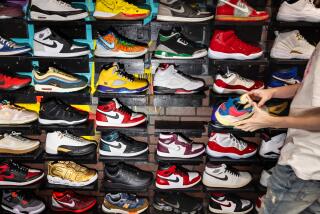By Design : The Time May Be Right, but a Lot Is Wrong With These Watches
- Share via
Time is money, especially when it’s kept by expensive, Swiss-made wristwatches. The Rolexes, Piagets, Cartiers on the wrists of men and women announce their owners’ position and status, and tell the world that they can afford the best.
Or at least they seem to.
At second glance, that seemingly expensive watch may be a counterfeit bought for $20 from a street vendor in New York or Bangkok, or at a swap meet or discount shop.
How can you tell a real one from a knockoff?
“Some fakes are very well done,” says Gary Elias, manager of Tourneau, a retailer of fine watches in South Coast Plaza, Costa Mesa. “We have even been occasionally fooled here.”
Most fakes are easy to spot. There’s no gold, the so-called leather band is plastic and the style is not consistent with the maker’s designs. The watches that concern Elias and Anthony D’Ambroscio, executive vice president of Tourneau in New York City, are the fakes that are bought by people who think they’re buying the genuine article and pay close to the retail price.
“Just because you buy a new product in a box from a store doesn’t mean it hasn’t had counterfeit parts added on or old parts substituted for new ones,” says D’Ambroscio.
Watchbands can be changed from 18-karat gold to 14-karat gold, dials can be switched and the insides can be altered.
There are no dealer warrantees with these watches, so the consumer pays hundreds of dollars for a “good deal” that may fall apart when the quartz battery runs down. D’Ambroscio recommends that consumers do these things before buying:
* Confirm that it’s real gold and not yellow metal.
* Check out the quality of the finish and the leather in the band.
* Ensure that the correct movements have not been substituted.
* Make certain that diamonds or other jewels are genuine.
“If you’re buying a fine watch, you really should educate yourself,” Elias says.
Cartier watches only have off-white colored dials, while fake Cartier may have a white dial. Also look at the Roman numerals. Cartier puts its name on the X on some models and the VII on others. (This can only be seen through a magnifying glass.)
“Making fake watches is a big, worldwide industry,” says Elias. “Legitimate watch companies have tried to stop them, but it’s very hard.”
Elias suggests that if you’re interested in a watch at a discount price, call the manufacturer to see if you’r dealing with an authorized dealer.
“If you don’t buy it from a dealer, there is no manufacturer’s guarantee and you will have to pay to have it fixed,” says Elias.
If the watch has been altered, the manufacturer may refuse to repair it.
“As in any fine product, you’re buying the labor and the craftsmanship. That’s what retains the value,” says D’Ambroscio. And that is what watch counterfeiters steal besides your money.
More to Read
Sign up for The Wild
We’ll help you find the best places to hike, bike and run, as well as the perfect silent spots for meditation and yoga.
You may occasionally receive promotional content from the Los Angeles Times.






